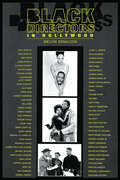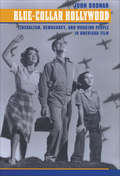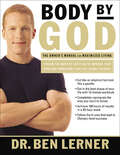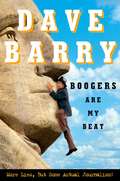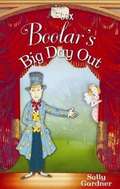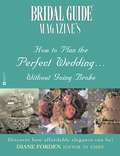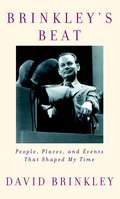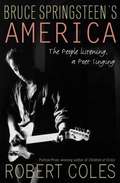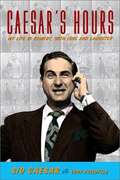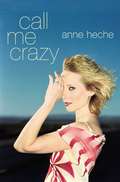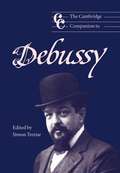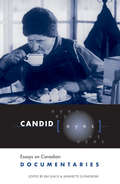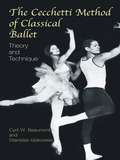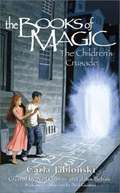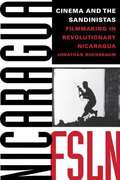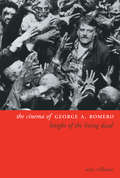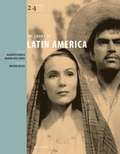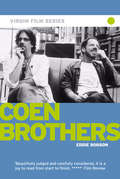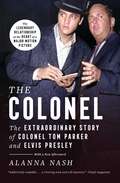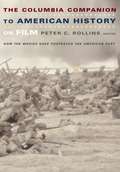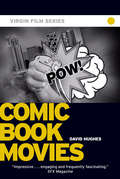- Table View
- List View
Black Directors in Hollywood
by Melvin DonalsonThis book offers a first comprehensive look at the work of black directors in Hollywood, from pioneers such as Gordon Parks, Melvin Van Peebles, and Ossie Davis to current talents including Spike Lee, John Singleton, Kasi Lemmons, and Carl Franklin. Discussing 67 individuals and over 135 films, Melvin Donalson thoroughly explores how black directors' storytelling skills and film techniques have widened both the thematic focus and visual style of American cinema. Assessing the meanings and messages in their films, he convincingly demonstrates that black directors are balancing Hollywood's demand for box office success with artistic achievement and responsibility to ethnic, cultural, and gender issues.
Blue-Collar Hollywood: Liberalism, Democracy, and Working People in American Film
by John BodnarSelected by Choice Magazine as an Outstanding Academic Title for 2003From Tom Joad to Norma Rae to Spike Lee's Mookie in Do the Right Thing, Hollywood has regularly dramatized the lives and struggles of working people in America. Ranging from idealistic to hopeless, from sympathetic to condescending, these portrayals confronted audiences with the vital economic, social, and political issues of their times while providing a diversion—sometimes entertaining, sometimes provocative—from the realities of their own lives.In Blue-Collar Hollywood, John Bodnar examines the ways in which popular American films made between the 1930s and the 1980s depicted working-class characters, comparing these cinematic representations with the aspirations of ordinary Americans and the promises made to them by the country's political elites. Based on close and imaginative viewings of dozens of films from every genre—among them Public Enemy, Black Fury, Baby Face, The Grapes of Wrath, It's a Wonderful Life, I Married a Communist, A Streetcar Named Desire, Peyton Place, Taxi Driver, Raging Bull, Coal Miner's Daughter, and Boyz N the Hood—this book explores such topics as the role of censorship, attitudes toward labor unions and worker militancy, racism, the place of women in the workforce and society, communism and the Hollywood blacklist, and faith in liberal democracy.Whether made during the Great Depression, World War II, the Cold War, or the Vietnam era, the majority of films about ordinary working Americans, Bodnar finds, avoided endorsing specific political programs, radical economic reform, or overtly reactionary positions. Instead, these movies were infused with the same current of liberalism and popular notion of democracy that flow through the American imagination.
Blues Journey
by Walter Dean MyersThe African experience in America is celebrated with a soulful, affecting blues poem that details the long journey from the Middle Passage to life today.
Body by God: The Owner's Manual for Maximized Living
by Ben LernerYour body is by God. God preprogrammed you to look great, have outrageous health, and experience incredible happiness. In the human body, God created a perfect design, equipped with all the organs, tissues, and cells necessary for health, production, and reproduction. The problem, asserts Dr. Ben Lerner, is when we as humans interfere with God's design for our bodies. Junk food, high-stress living, and neglecting exercise are just a few of the things we do to hinder our bodies' performance.In Body by God, Dr. Lerner offers a comprehensive plan for getting in touch with our bodies in four areas: nutrition, exercise, stress management, and time management. His "5-in-5" plan is designed to instill the good habits that will lead to optimum health benefits. Readers will learn how to get in shape with 10-minute workouts, reprogram the way they react to stress, and more. "Owner's Manual Tips" give specific ways to apply the material to real life. Our bodies are "fearfully and wonderfully made." With the help of Body by God, readers will learn how to achieve the highest level of performance from God's handiwork.
Boogers Are My Beat: More Lies, But Some Actual Journalism
by Dave BarryThe New York Times calls him "the funniest man in America," and his legions of fans agree, laughing and snorting as they put his books on bestseller lists nationwide. In Boogers Are My Beat, Dave gives us the real scoop on: * The scientific search for the world's funniest joke (you can bet it includes the word "weasel") * RV camping in the Wal-Mart parking lot * Outwitting "smart" kitchen appliances and service contracts * Elections in Florida ("You can't spell Florida without 'duh'") * The Olympics, where people from all over the world come together to accuse each other of cheating * The truth about the Dakotas, the Lone Ranger, and feng shui * The choice between death and taxes And much, much more--including some truths about journalism and serious thoughts about 9/11. Dave Barry won the Pulitzer Prize for commentary in 1988, and his columns are syndicated in more than 500 newspapers. His most recent books, Dave Barry Is Not Taking This Sitting Down and the novels Big Trouble and Tricky Business, were national bestsellers. He lives in Miami, Floriduh.
Boolar’s Big Day Out
by Sally GardnerAfter Boolar is asked to join a puppet theater he forgets about the dolls and mice who have been his family, until a crisis helps him regain perspective.
Bridal Guide Magazine's How to Plan the Perfect Wedding Without Going Broke
by Diane FordenFor the first time, the experts at Bridal Guide, America's leading bridal magazine, have gathered all of their favorite cost-containing tips and stress-reducing strategies into one handy volume. This comprehensive, practical wedding planner offers hundreds of insider tips for cutting back on wedding costs without cutting back on style. From etiquette to officiants, transportation to tipping, and registry to rehearsal dinners, Bridal Guide's Diane Forden spells it all out for you. Charts, checklists, and calendars keep you on track and simplify each stage of the planning process.
Brinkley's Beat: People, Places and Events that Shaped My Time
by David BrinkleyHere are firsthand profiles of Washington insiders that only an insider himself could have given us: Franklin D. Roosevelt counting out enough cigarettes to get through a half-hour debriefing with the press; May Craig, the first female reporter to penetrate Roosevelt's inner sanctum, who never failed to remind the president that his wife was a newspaper writer, too; Theodore Bilbo, a Mississippi senator and race baiter who effectively became mayor of Washington at a time when it was a segregated provincial town; Jimmy Hoffa, the popular and ill-fated union leader; Lyndon Johnson, whom Brinkley describes as the most impressive and appalling figure he encountered; and Ronald Reagan, whom he found to be the most mysterious of the eleven presidents he covered. Here is also Brinkley's account of President Kennedy's assassination and a poignant remembrance of D-day. David Brinkley was there and saw it all. In the "sour-lovable manner" (Mark Feeney, Boston Globe) of storytelling that he perfected, and in a narrative style that is both "hilarious and instructive" (George Will), Brinkley's Beat gives us his vivid recollections and the intelligence, acuity, and clear-sightedness on which his unimpeachable reputation rested for more than half a century.
Bruce Springsteen's America
by Robert ColesIn this compelling book, Robert Coles, the celebrated Harvard professor and Pulitzer Prize-winning author, turns his attention to popular music legend Bruce Springsteen, and to the powerful impact Springsteen's work has had both on the lives of his audience and on this country's literary tradition. Coles places Springsteen in the pantheon of American artists--Walt Whitman, William Carlos Williams, Dorothea Lange, and Walker Percy, among others--who understood and were inspired by their "traveling companions in time," the ordinary people of their eras. With wisdom and a unique personal perspective, Coles explores Springsteen's words as contemporary American poetry, and offers firsthand accounts of how people interact with them: A trucker listens to "Blinded by the Light" during long, lonely nights and reminisces about his mother; a schoolteacher is astonished when a usually silent student offers a comparison between "Nebraska" and Conrad's Heart of Darkness; a policeman responds to "American Skin (41 Shots)," reflecting on his own role in his family and community. As these people, and others, candidly discuss the meaning Springsteen's words have in their lives, Coles listens and, with the special insight and compassion that are the trademarks of his art, sheds new light on "The Boss," removing the legendary American rock musician from fan-filled stadiums and placing the poet in a greater social, cultural, and philosophical context. Coles sees Springsteen as a representative of a uniquely American documentary tradition--as a singing and traveling poet who does not simply embody the culture of which he is a part but fully engages it, interacting with its people and creating a conversation that has helped to shape a distinct way of looking at, and living, American life today.
Caesar's Hours: My Life in Comedy, with Love and Laughter
by Sid Caesar Eddy FriedfeldThe legendary television star tells the backstage stories of the classic comedy of Your Show of Shows, Caesar's Hour , and other landmark programs. It is no exaggeration to say that without Sid Caesar, comedy in America would have been a lot less funny. He was the star and guiding force behind Your Show of Shows and Caesar's Hour , two of the most innovative programs in the Golden Age of Television, and the writers and stars of those shows went on to create the plays, movies, and sitcoms that we now think of as classic American comedy. So many of our greatest comedy writers - Carl Reiner, Mel Brooks, Neil Simon, Larry Gelbart, Woody Allen -were part of Sid Caesar's creative troupe. Sid was a master not only of comedic performance, but also of developing characters that the audience could relate to, finding the humor in ordinary situations rather than through vaudeville-type gags. His was a comedy truly drawn from the human condition. Caesar's Hours is Sid Caesar 's artistic autobiography, his account of how these great routines were fashioned and performed, and the interactions that gave birth to them. He takes us inside the famed writers' room, the rehearsal studios, and onto the stage itself, where some of the funniest moments in television history came to life. To read his book is to learn why his intelligent and sensitive brand of humor resonates so much with us, even half a century later.
Call Me Crazy
by Anne HecheA beautifully written and evocative memoir of pain and redemption, of hurt and healing, from an actress whose private life and personal choices have made her a household name. "My life is a life movies are made of," wrote Anne Heche in the proposal for her memoir. Yet what is truly surprising about Heche is that the most publicized event of her past -- her romance with Ellen DeGeneres -- is only one development in a fascinating and difficult life that has included more than its share of heartache and tragedy. Heche's memoir reveals the woman behind the headlines, one who has conquered overwhelming odds. Far from a celebrity memoir, this is an empowering and thought-provoking book guaranteed to surprise and inspire.
The Cambridge Companion to Debussy
by Simon TreziseOften considered the father of twentieth-century music, Debussy was a visionary whose influence is still felt. This Companion offers new insights into Debussy's character, his environment and his music, including challenging views of the roles of nature and eroticism in his life and music. While works in all genres are discussed, they are considered through the themes of sonority, rhythm, tonality and form, with closing chapters considering the performance and reception of his music in the first years of the new century.
Candid Eyes
by Jeannette Sloniowski Jim LeachBeginning in 1922, when Robert Flaherty filmed 'Nanook of the North' in Canada's Arctic, and encouraged by John Grierson and the federal government in 1939 when they created the National Film Board of Canada (NFB), documentaries have dominated Canada's film production and, more than any other form, have been crucial to the formation of Canada's cinematic identity.Surprisingly, there has been very little critical writing on this distinguished body of work. Candid Eyes: Essays on Canadian Documentaries not only addresses this oversight in the scholarly literature, but in doing so, it presents an exceptional collection of essays by some of Canada's best known film scholars. Focusing on works produced in French and English under the NFB umbrella, the fourteen essays discuss and critique such landmark documentaries as 'Lonely Boy' (1962), 'Pour la suite du monde' (1963), and 'Kanehsatake' (1993). Long awaited and much needed, this volume will be an indispensable companion for anyone seriously interested in Canadian film studies.
The Cecchetti Method of Classical Ballet: Theory and Technique
by Cyril W. Beaumont Stanislas IdzikowskiThis dance classic presents a complete beginning course in classical ballet. The founder of this method, Enrico Cecchetti (1850–1928), performed and taught in Russia and with Diaghilev's troupe. By elaborating on a logical progression of exercises, Cecchetti provided dance with an unprecedented unity — balancing the adagio and allegro, re-establishing the notion of "legato," strengthening the arabesque, and developing the exercise of the pliés. Cyril W. Beaumont, a distinguished writer on ballet, has codified Cecchetti's program of study with the assistance of one of Cecchetti's star pupils, Stanislas Idzikowski, and with the approval of Cecchetti himself.The first chapter defines and illustrates the basic theory of the positions, body movements, and technical terms. Detailed chapters of exercises include "Exercises at the Bar," "Port de Bras," "Centre Practice," "Adagio," and "Allegro." Each exercise appears with a numbered series of instructions, and a table of daily exercises for the week is provided. The text is accompanied by 109 line illustrations, showing positions and movements of the body in detail and offering ballet lovers a perfect guide to the basics of classical ballet.
The Children's Crusade (The Books of Magic #3)
by Carla JablonskiDo you believe in magic? Timothy Hunter is just like any other thirteen-year-old boy in London . . . except for the tiny fact that he might be the most powerful magician of his time. There is a secret world for children in danger, and right now it needs Tim's power to survive. But how can he help when he is still trying to figure out how to use his magic -- and when certain dark forces seem to have sinister plans of their own?
Cinema and the Sandinistas: Filmmaking in Revolutionary Nicaragua
by Jonathan BuchsbaumUsing a wealth of firsthand documentation—the films themselves, interviews with numerous INCINE personnel, and INCINE archival records—Jonathan Buchsbaum follows the evolution of INCINE's project and situates it within the larger historical project of militant, revolutionary filmmaking in Latin America. His research also raises crucial questions about the viability of national cinemas in the face of accelerating globalization and technological changes which reverberate far beyond Nicaragua's experiment in revolutionary filmmaking.
The Cinema of George A. Romero: Knight of the Living Dead (Directors' Cuts)
by Tony WilliamsThe Cinema of George A. Romero: Knight of the Living Dead is the first in-depth study in English of the career of this foremost auteur working at the margins of the Hollywood mainstream in the horror genre. In placing Romero's oeuvre in the context of literary naturalism, the book explores the relevance of the director's films within American cultural traditions and thus explains the potency of such work beyond 'splatter movie' models. The author explores the roots of naturalism in the work of Emile Zola and traces this through to the EC Comics of the 1950s and on to the work of Stephen King. In so doing, the book illuminates the importance of seminal Romero texts such as Night of the Living Dead (1968), Creepshow (1982), Monkey Shines (1988), The Dark Half (1992). This study also includes full coverage of Romero's latest feature, Bruiser (2000), as well as his screenplays and teleplays.
The Cinema of George A. Romero
by Tony WilliamsThe Cinema of George A. Romero: Knight of the Living Dead is the first in-depth study in English of the career of this foremost auteur working at the margins of the Hollywood mainstream in the horror genre. In placing Romero's oeuvre in the context of literary naturalism, the book explores the relevance of the director's films within American cultural traditions and thus explains the potency of such work beyond 'splatter movie' models. The author explores the roots of naturalism in the work of Emile Zola and traces this through to the EC Comics of the 1950s and on to the work of Stephen King. In so doing, the book illuminates the importance of seminal Romero texts such as Night of the Living Dead (1968), Creepshow (1982), Monkey Shines (1988), The Dark Half (1992). This study also includes full coverage of Romero's latest feature, Bruiser (2000), as well as his screenplays and teleplays.
The Cinema of Latin America (24 Frames)
by Alberto Elena Díaz López Marina Eds.The Cinema of Latin America is the first volume in the new 24 Frames series of studies of national and regional cinema. In taking an explicitly text-centered approach, the books in this series offer a unique way of considering the particular concerns, styles and modes of representation of numerous national cinemas around the world. This volume focuses on the vibrant practices that make up Latin American cinema, a historically important regional cinema and one that is increasingly returning to popular and academic appreciation. Through 24 individual concise and insightful essays that each consider one significant film or documentary, the editors of this volume have compiled a unique introduction to the cinematic output of countries as diverse as Brazil, Argentina, Cuba, Mexico, Bolivia, Chile and Venezuala. The work of directors such as Luis Buñuel, Thomas Guiterrez Alea, Walter Salles, and Alfonso Arau is discussed and the collection includes in-depth studies of seminal works as such Los Olvidados, The Hour of the Furnaces, Like Water For Chocolate, Foreign Land, and Amoros Perros.
The Cinema of Latin America
by Alberto Elena Díaz López MarinaThe Cinema of Latin America is the first volume in the new 24 Frames series of studies of national and regional cinema. In taking an explicitly text-centered approach, the books in this series offer a unique way of considering the particular concerns, styles and modes of representation of numerous national cinemas around the world. This volume focuses on the vibrant practices that make up Latin American cinema, a historically important regional cinema and one that is increasingly returning to popular and academic appreciation. Through 24 individual concise and insightful essays that each consider one significant film or documentary, the editors of this volume have compiled a unique introduction to the cinematic output of countries as diverse as Brazil, Argentina, Cuba, Mexico, Bolivia, Chile and Venezuala. The work of directors such as Luis Buñuel, Thomas Guiterrez Alea, Walter Salles, and Alfonso Arau is discussed and the collection includes in-depth studies of seminal works as such Los Olvidados, The Hour of the Furnaces, Like Water For Chocolate, Foreign Land, and Amoros Perros.
Coen Brothers - Virgin Film (Virgin Film Ser.)
by Eddie RobsonJoel and Ethan Coen make up one of the most original and unconventional movie-making partnerships to come out of America at the end of the 20th century. From their debut tour de force Blood Simple to the hugely acclaimed The Man Who Wasn't There, the brothers' films have attracted critical kudos and commercial success in equal measure due to their irreverent, individual and technically virtuoso nature. Each of their films defies categorisation, yet you're never in any doubt you're watching a Coen brothers movie. This exploration of the movie career of Hollywood's best-loved outsiders charts their rise from cult favourites to box-office contenders, whilst combining indispensable reference material and critical analysis of their films.
The Colonel: The Extraordinary Story of Colonel Tom Parker and Elvis Presley
by Alanna NashIn The Colonel, Alanna Nash, the author of Golden Girl: The Story of Jessica Savitch, explores in depth the amazing story of Colonel Tom Parker, the man behind the legend and the myth of Elvis Presley. The result is a book that reads like the most riveting of real-life detective stories -- one that will completely change your view of Presley's life, success, and death. While scores of books have been written about Elvis Presley, this is the first meticulously researched biography of Tom Parker written by someone who knew him personally. And for anyone truly interested in the performer many consider the greatest and most influential of the twentieth century, it is impossible to understand how Elvis came to be such a phenomenon without examining the life and mind of Parker, the man who virtually controlled Elvis's every move. Alanna Nash has been covering the story of Elvis Presley and Colonel Tom Parker since the day of Presley's funeral in Memphis, Tennessee. She was the first journalist allowed to view Presley's body, a compelling and surprising sight. But the profile of Parker attending the funeral in a Hawaiian shirt and a baseball cap was even stranger, and led her to investigate the man behind the myth. It has been known for twenty years that Thomas Andrew Parker was, in fact, born in Holland as Andreas Cornelis van Kuijk. But Nash has dug much deeper and, in a masterpiece of reporting, unearthed never-before-seen documents, including Parker's army records and psychiatric evaluations, and the original police report of an unsolved murder case in Holland that lies at the heart of the Parker mystery. In the process of weighing the evidence, she answers the biggest riddle in the history of the music industry, as it becomes clear that every move Parker made in the handling of Elvis Presley -- from why he never allowed Elvis to perform in Europe, to why he didn't halt Elvis's drug use, to why he put him in so many mediocre movies, and even the Colonel's direction of Presley's army career -- was designed to protect Parker's own secrets. Filled with startling new material, her book challenges even the most familiar precepts of the Presley saga -- everything we presumed about Parker's handling of the world's most famous entertainer must now be reevaluated in the light of information Nash reveals about Parker, who cared little for Presley beyond what the singer could do to bolster the Colonel's precarious position as an illegal alien. Elvis Presley, as one of Parker's unwitting victims, paid a major price for the Colonel's past and his overwhelming need to be more important than his client. As a result, Presley was never allowed to reach his potential and died in drug-induced frustration over his stunted and mismanaged career. In this astonishing, impeccably written, and vastly entertaining book, Nash proves that the only figure in American popular culture as fascinating as Elvis Presley is Colonel Tom Parker, the man who shaped Elvis, who in turn helped shape us.
The Columbia Companion to America History on Film
by Peter C. RollinsIn this collection, more than seventy scholars examine how filmmakers have presented and interpreted the most important events, topics, eras, and figures in the American past, often comparing the film versions of events with interpretations by leading historians. Divided into eight broad categories-Eras; Wars and Other Major Events; Notable People; Groups; Institutions and Movements; Places; Themes and Topics; and Myths and Heroes-the volume features extensive filmographies (of discussed and relevant films), notes, and bibliographies of selected historical works and is united by a detailed index.
The Columbia Companion to American History on Film: How the Movies Have Portrayed the American Past
by Rollins Peter C. Ed.American history has always been an irresistible source of inspiration for filmmakers, and today, for good or ill, most Americans'sense of the past likely comes more from Hollywood than from the works of historians. In important films such as The Birth of a Nation (1915), Roots (1977), Apocalypse Now (1979), and Saving Private Ryan (1998), how much is entertainment and how much is rooted in historical fact? In The Columbia Companion to American History on Film, more than seventy scholars consider the gap between history and Hollywood. They examine how filmmakers have presented and interpreted the most important events, topics, eras, and figures in the American past, often comparing the film versions of events with the interpretations of the best historians who have explored the topic. Divided into eight broad categories—Eras; Wars and Other Major Events; Notable People; Groups; Institutions and Movements; Places; Themes and Topics; and Myths and Heroes—the volume features extensive cross-references, a filmography (of discussed and relevant films), notes, and a bibliography of selected historical works on each subject. The Columbia Companion to American History on Film is also an important resource for teachers, with extensive information for research or for course development appropriate for both high school and college students.Though each essay reflects the unique body of film and print works covering the subject at hand, every essay addresses several fundamental questions: What are the key films on this topic? What sources did the filmmaker use, and how did the film deviate (or remain true to) its sources? How have film interpretations of a particular historical topic changed, and what sorts of factors—technological, social, political, historiographical—have affected their evolution? Have filmmakers altered the historical record with a view to enhancing drama or to enhance the "truth" of their putative message?
Comic Book Movies - Virgin Film
by David HughesThe superheroes are back! Since the 1970s, the film world has found inspiration in comic books and graphic novels. These days no summer is complete without a major blockbuster movie based on a comic: Superman, Batman, Spider-Man, X-Men, Men in Black, Daredevil, and The Hulk. Modern special effects have made large-scale superhero epics possible, but the diversity of the comics being published has made for a wide variety of subjects, as evidenced by Ghost World, From Hell, Akira and Road to Perdition. This book looks in detail at twenty key titles, covering every step of the development from comic book panel to feature film frame. Includes interviews with key creative artists about the evolution of the films from the original comics, and speculates about future films.
